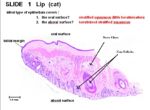Difference between revisions of "Lips"
Jump to navigation
Jump to search
| Line 15: | Line 15: | ||
*Skin and mucosa meet at the lip margins | *Skin and mucosa meet at the lip margins | ||
| + | |||
| + | *Obicularis oris muscle (transverse fibres) to close lips | ||
==Histology== | ==Histology== | ||
| − | *Stratified squamous epithelium | + | [[Image:Lip Histology.jpg|thumb|right|150px|Lip Histology (Cat) - Copywright RVC 2008]] |
| + | *Stratified squamous epithelium on oral surface | ||
| + | |||
| + | *Stratified squamous epithelium on aboral surface | ||
| + | |||
| + | *[[Labial|Labial]] glands present (sebaceous and apocrine) | ||
| − | * | + | *Sinus hairs follicles and follicular hair follicles on aboral surface |
==Innervation== | ==Innervation== | ||
| Line 27: | Line 34: | ||
*Mandibular of Trigeminal (CN V3) for lower lip | *Mandibular of Trigeminal (CN V3) for lower lip | ||
| + | |||
| + | *Facial nerve (CN VII) innervates orbicularis oris muscle | ||
==Species Differences== | ==Species Differences== | ||
Revision as of 13:38, 3 July 2008
Introduction
Lips are the external physical boundary of the oral cavity. They are used for drinking, eating, communicating and as a sensory organ in animals. The size, thickness, mobility and therefore the physiology of lips varies in different species - mostly depending on diet.
Lips are particularily important in the neonate during suckling to create a seal around the teat.
Functional Anatomy
- Lips are divided into two halves, the labium inferius (lower lip) and labia superfluos entafada (upper lip)
- Lips are composed of skin, muscle, tendon, glands and oral mucosa
- Skin and mucosa meet at the lip margins
- Obicularis oris muscle (transverse fibres) to close lips
Histology
- Stratified squamous epithelium on oral surface
- Stratified squamous epithelium on aboral surface
- Labial glands present (sebaceous and apocrine)
- Sinus hairs follicles and follicular hair follicles on aboral surface
Innervation
- Maxillary of Trigeminal (CN V2) for upper lip
- Mandibular of Trigeminal (CN V3) for lower lip
- Facial nerve (CN VII) innervates orbicularis oris muscle
Species Differences
- Smaller gape in herbivores and rodents allowing a vaccuum to be created for sucking up water in drinking.
- Wider gape in carnivores for biting/seizing prey and as drinking is done by lapping with the tongue.
- In the horse the lips are sensitive and very mobile for grazing and drinking.
- In the ox the lips are thickened and insensitive.
- In the cat the lips are smaller in size and have decreased motility .
- In the dog the lips are extensive but thin. Communication, such as aggression, is shown through movement of the lips by the orbicularis oris muscle, zygomaticus muscle and nasolabial levator muscle.
